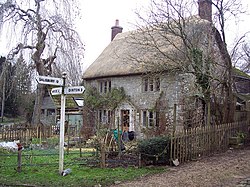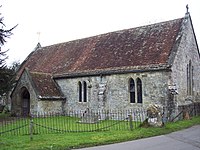Teffont Magna
| Teffont Magna | |
| Wiltshire | |
|---|---|
 Signpost and cottage, Teffont Magna | |
| Location | |
| Grid reference: | ST989323 |
| Location: | 51°5’24"N, 2°1’1"W |
| Data | |
| Post town: | Salisbury |
| Postcode: | SP3 |
| Dialling code: | 01722 |
| Local Government | |
| Council: | Wiltshire |
| Parliamentary constituency: |
South West Wiltshire |
Teffont Magna, sometimes called Upper Teffont, is a small village in the south of Wiltshire, sitting in the Nadder valley. The village is to be found a mile and a half to the west of Dinton and seven miles west of Wilton. It sits between Chilmark and Dinton on the B3089 Hindon to Barford St Martin road, in the valley of a stream which rises just to the north and flows south through Teffont Evias to join the Nadder.[1]
For most of its history Teffont Magna was a chapelry of neighbouring Dinton. The parish extends north onto the chalk downs that separate the valleys of the Nadder and Wylye.[1]
History
The north boundary of the ancient parish, and hence also of the modern parish, is a prehistoric linear earthwork called Grim's Ditch.[2] A hillfort of uncertain age known as Wick Ball Camp stands on a hilltop in the east of the parish, straddling the boundary with Dinton.[3] There is a Roman site to the south-west of the village.[4]
The 15th-century cartulary of Shaftesbury Abbey includes two charters which refer to land in "Teffont". The first is dated 860, and in it King Æthelbald grants fourteen cassati (hides) to a thegn named Osmund. In the second, of 964, King Edgar granted five cassati to the thegn Sigestan. As Shaftesbury Abbey owned the manor of Teffont Magna by the time of the Norman Conquest, the charters may refer to parts of it.
There is no mention of Teffont Magna in the Domesday Book, where it may be included under Dinton, another of the Abbey's manors.
After the Dissolution of the Monasteries, Teffont Magna was acquired with Dinton by William Herbert, who later became Earl of Pembroke. It remained with his successors as Earls of Pembroke until 1919, when it was sold to Lord Bledisloe. In 1950 his younger son, Charles Hiley Bathurst, sold the estate to John Jacob Astor, who a year later broke the estate up by selling it in several lots.[1]
Fitz House, the largest in the village, was built in the mid-17th century in dressed limestone and with mullioned windows; a left wing was added in 1700 and converted from a wool store to living accommodation in the 1920s.[5] Close to the house is a 15th-century thatched barn.[6]
According to Wilson's Imperial Gazetteer of England and Wales (1870–1872):
A small school was built in the village around the 1870s, and in 1893 the average attendance was 52.[1] After it was closed in 1936, children attended schools in Dinton or Wilton; the building remains in use as the village hall.[8]
An etching of Teffont Magna by the artist John Piper was released in an edition of seventy prints in 1988.[9]
Church

The 13th century Church of England church was for much of its existence a chapel of ease of Dinton, and thus evaded the notice of any Victorian restoration and is substantially original.
In rubble stone with dressed limestone, the building has a simple plan, with a four-bay nave and chancel under one roof; the 14th-century south porch has its original roof timbers.[10] There is no tower, instead a niche in the west gable houses two bells. One of the bells, thought to date from the 13th century, became cracked and was moved into the church in 1930; in 1947 its replacement was installed and the second bell was recast.[1]
Inside are flagstone floors and a wooden chancel screen from the early 16th century. The cylindrical font is from the 12th century, and set into a wall is a fragment of a Saxon cross with fine carving.[10][11] In 1965 no dedication was recorded for the church, and in that year it was named St Edward's, for Edward the Martyr, king and saint.[12] The church is a Grade II* listed building.[10]
As a chapel of ease for St Mary's at Dinton, just a mile away as the crow flies, Teffont Magna was always served by the vicar of Dinton or his curate. In 1922 it was detached from Dinton and united with Teffont Evias to form the parish of Teffont Evias with Teffont Magna; today called the 'Nadder Valley team' and covering fourteen parishes with sixteen churches.[13]
The burial ground on the other side of the lane was consecrated in 1925.[1]
Outside links
| ("Wikimedia Commons" has material about Teffont Magna) |
References
- ↑ 1.0 1.1 1.2 1.3 1.4 1.5 A History of the County of Wiltshire - Volume 8 pp 74–78: Teffont Magna (Victoria County History)
- ↑ National Heritage List 1005606: Ditch, 343yds ENE of East Farm Cottages to 800yds NW of St Martin's Chapel (Scheduled ancient monument entry)
- ↑ National Heritage List 1005673: Wick Ball camp, the Common (Scheduled ancient monument entry)
- ↑ National Heritage List 1004715: Roman site in Upper Holt (Scheduled ancient monument entry)
- ↑ National Heritage List 1146263: Fitz House (Grade II listing)
- ↑ National Heritage List 1146264: Barn at Fitz House (Grade II listing)
- ↑ Teffont Magna at visionofbritain.org.uk
- ↑ "Village Hall". https://www.teffont.com/index.php/village-hall.
- ↑ Architects' Journal, vol. 193 (Architectural Press, 1991), p. 68
- ↑ 10.0 10.1 10.2 National Heritage List 1251111: Church of St Edward (Grade II* listing)
- ↑ Wiltshire archaeological and natural history magazine, volume 48 (1939), p. vi
- ↑ Teffont Magna church at teffont.com. Retrieved 16 November 2010.
- ↑ "Nadder Valley (Team Ministry)". https://www.achurchnearyou.com/church/9534/benefice/. Retrieved 3 May 2020.
